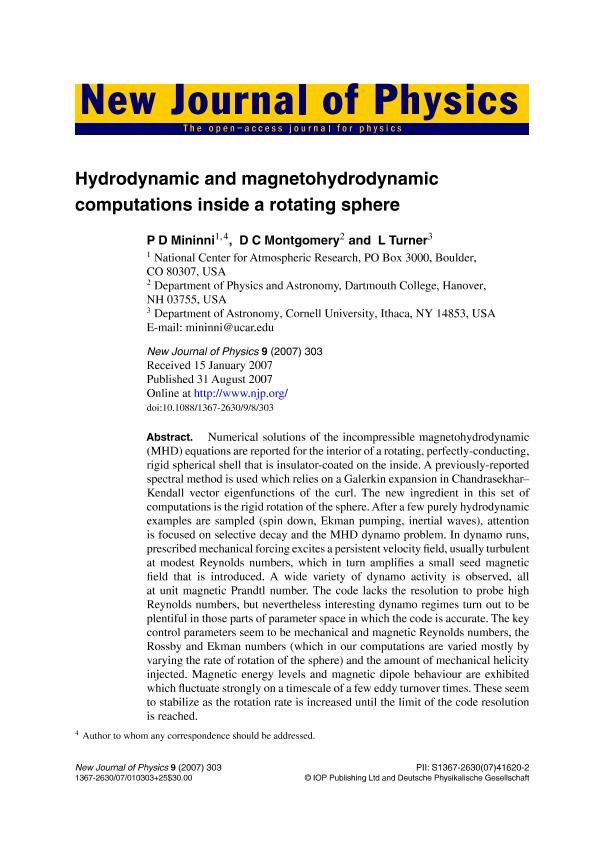Mostrar el registro sencillo del ítem
dc.contributor.author
Mininni, Pablo Daniel

dc.contributor.author
Montgomery, D.C.
dc.contributor.author
Turner, L.
dc.date.available
2019-01-09T17:19:42Z
dc.date.issued
2007-12
dc.identifier.citation
Mininni, Pablo Daniel; Montgomery, D.C.; Turner, L.; Hydrodynamic and magnetohydrodynamic computations inside a rotating sphere; IOP Publishing; New Journal of Physics; 9; 8; 12-2007; 3031-30325
dc.identifier.issn
1367-2630
dc.identifier.uri
http://hdl.handle.net/11336/67766
dc.description.abstract
Numerical solutions of the incompressible magnetohydrodynamic (MHD) equations are reported for the interior of a rotating, perfectly-conducting, rigid spherical shell that is insulator-coated on the inside. A previously-reported spectral method is used which relies on a Galerkin expansion in Chandrasekhar-Kendall vector eigenfunctions of the curl. The new ingredient in this set of computations is the rigid rotation of the sphere. After a few purely hydrodynamic examples are sampled (spin down, Ekman pumping, inertial waves), attention is focused on selective decay and the MHD dynamo problem. In dynamo runs, prescribed mechanical forcing excites a persistent velocity field, usually turbulent at modest Reynolds numbers, which in turn amplifies a small seed magnetic field that is introduced. A wide variety of dynamo activity is observed, all at unit magnetic Prandtl number. The code lacks the resolution to probe high Reynolds numbers, but nevertheless interesting dynamo regimes turn out to be plentiful in those parts of parameter space in which the code is accurate. The key control parameters seem to be mechanical and magnetic Reynolds numbers, the Rossby and Ekman numbers (which in our computations are varied mostly by varying the rate of rotation of the sphere) and the amount of mechanical helicity injected. Magnetic energy levels and magnetic dipole behaviour are exhibited which fluctuate strongly on a timescale of a few eddy turnover times. These seem to stabilize as the rotation rate is increased until the limit of the code resolution is reached. © IOP Publishing Ltd and Deutsche Physikalische Gesellschaft.
dc.format
application/pdf
dc.language.iso
eng
dc.publisher
IOP Publishing

dc.rights
info:eu-repo/semantics/openAccess
dc.rights.uri
https://creativecommons.org/licenses/by-nc-sa/2.5/ar/
dc.subject.classification
Astronomía

dc.subject.classification
Ciencias Físicas

dc.subject.classification
CIENCIAS NATURALES Y EXACTAS

dc.title
Hydrodynamic and magnetohydrodynamic computations inside a rotating sphere
dc.type
info:eu-repo/semantics/article
dc.type
info:ar-repo/semantics/artículo
dc.type
info:eu-repo/semantics/publishedVersion
dc.date.updated
2019-01-09T14:23:37Z
dc.journal.volume
9
dc.journal.number
8
dc.journal.pagination
3031-30325
dc.journal.pais
Reino Unido

dc.journal.ciudad
Londres
dc.description.fil
Fil: Mininni, Pablo Daniel. National Center for Atmospheric Research; Estados Unidos. Consejo Nacional de Investigaciones Científicas y Técnicas. Oficina de Coordinación Administrativa Ciudad Universitaria. Instituto de Física de Buenos Aires. Universidad de Buenos Aires. Facultad de Ciencias Exactas y Naturales. Instituto de Física de Buenos Aires; Argentina
dc.description.fil
Fil: Montgomery, D.C.. Dartmouth College; Estados Unidos
dc.description.fil
Fil: Turner, L.. Cornell University; Estados Unidos
dc.journal.title
New Journal of Physics

dc.relation.alternativeid
info:eu-repo/semantics/altIdentifier/doi/http://dx.doi.org/10.1088/1367-2630/9/8/303
Archivos asociados
